Mises, Ludwig von. Human Action: A Treatise on Economics
Подождите немного. Документ загружается.

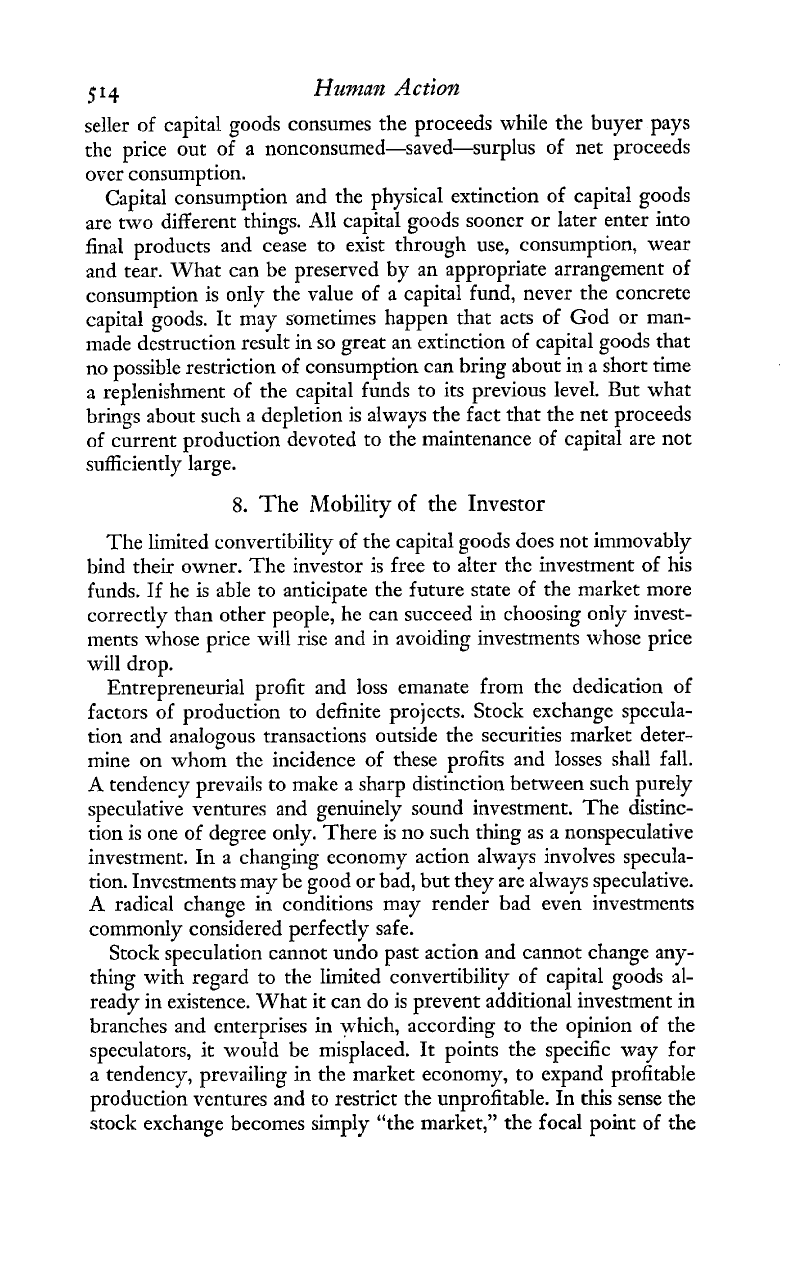
5'4
Human
Action
seller of capital goods consumes the proceeds while the buyer pays
the price out of a
nonconsumed-saved-surplus
of net proceeds
over consumption.
Capital consumption and the physical extinction of capital goods
are two different things.
A11
capital goods sooner or later enter into
final products and cease to exist through use, consumption, wear
and tear. What can be preserved by an appropriate arrangement of
consumption is only the value of a capital fund, never the concrete
capital goods. It may sometimes happen that acts of God or man-
made destruction result in so great an extinction of capital goods that
no possible restriction of consumption can bring about in a short time
a replenishment of the capital funds to its previous level. But what
brings about such a depletion is always the fact that the net proceeds
of current production devoted to the maintenance of capital are not
sufficiently large.
8.
The Mobility of the Investor
The limited convertibility of the capital goods does not immovably
bind their owner. The investor is free to alter the investment of his
funds. If he is able to anticipate the future state of the market more
correctly than other people, he can succeed in choosing only invest-
ments whose price will rise and in avoiding investments whose price
will drop.
Entrepreneurial profit and loss emanate from the dedication of
factors of production to definite projects. Stock exchange specula-
tion and analogous transactions outside the securities market deter-
mine on whom the incidence of these profits and losses shall fall.
A
tendency prevails to make a sharp distinction between such purely
speculative ventures and genuinely sound investment. The distinc-
tion is one of degree only. There is no such thing as a nonspeculative
investment.
In
a changing economy action always involves specula-
tion. Investments may be good or bad, but they are always speculative.
A
radical change in conditions may render bad even investments
commonly considered perfectly safe.
Stock speculation cannot undo past action and cannot change any-
thing with regard to the limited convertibility of capital goods al-
ready in existence. What it can do is prevent additional investment in
branches and enterprises in yhich, according to the opinion of the
speculators, it would be misplaced. It points the specific way for
a tendency, prevailing in the market economy, to expand profitable
production ventures and to restrict the unprofitable. In this sense the
stock exchange becomes simply "the market," the focal point of the
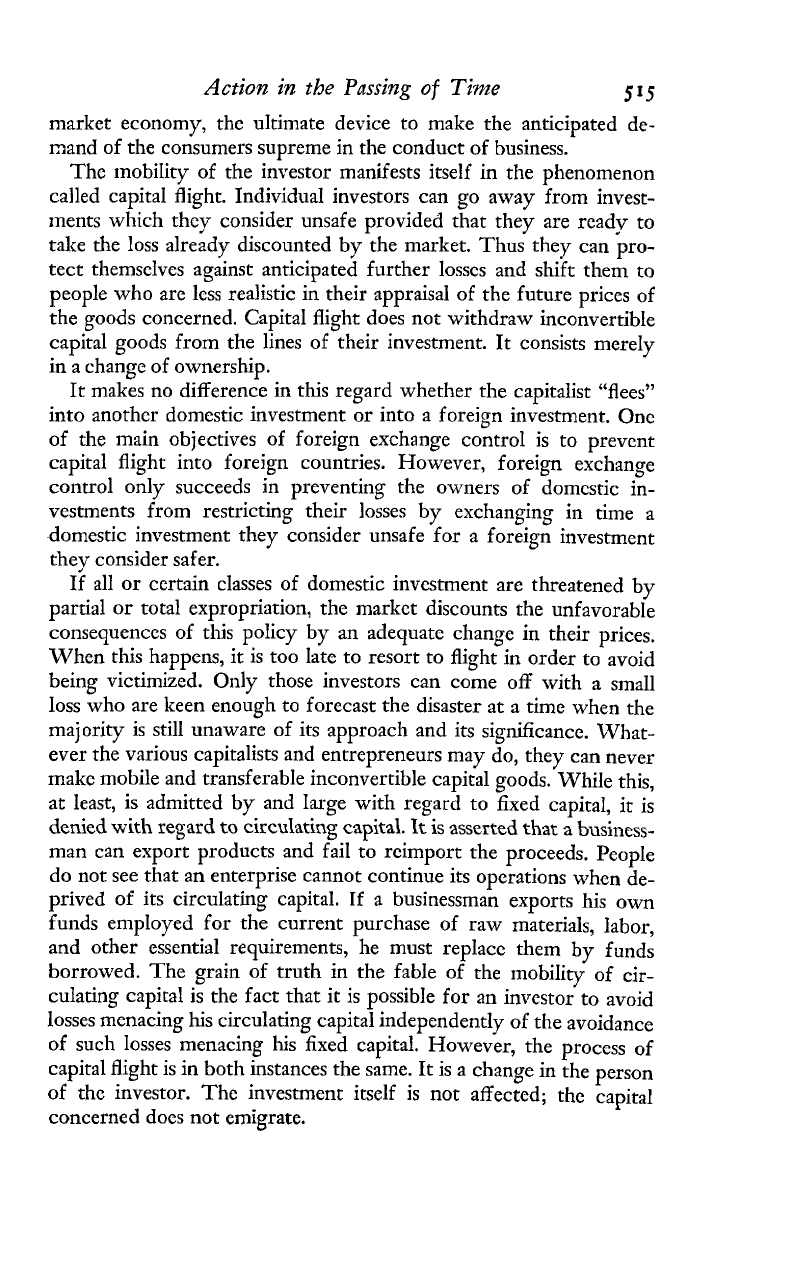
Action in
the
Passing
of
Time
515
market economy, the ultimate device to make the anticipated de-
mand of the consumers supreme in the conduct of business.
The mobility of the investor manifests itself in the phenomenon
called capital flight. Individual investors can go away from invest-
ments which they consider unsafe provided that they are ready to
take the loss already discounted by the market. Thus they can pro-
tect themselves against anticipated further losses and shift them to
people who are less realistic in their appraisal of the future prices of
the goods concerned. Capital flight does not withdraw inconvertible
capital goods from the lines of their investment. It consists merely
in a change of ownership.
It makes no difference in this regard whether the capitalist "flees"
into another domestic investment or into a foreign investment. One
of the main objectives of foreign exchange control is to prevent
capital flight into foreign countries. However, foreign exchange
control only succeeds in preventing the owners of domestic in-
vestments from restricting their losses by exchanging in time a
domestic investment they consider unsafe for a foreign investment
they consider safer.
If all or certain classes of domestic investment are threatened by
partial or total expropriation, the market discounts the unfavorable
consequences of this policy by an adequate change in their prices.
When this happens, it is too late to resort to flight in order to avoid
being victimized. Only those investors can come off with a small
loss who are keen enough to forecast the disaster at a time when the
majority is still unaware of its approach and its significance. What-
ever the various capitalists and entrepreneurs may do, they can never
make mobile and transferable inconvertible capital goods. While this,
at least, is admitted by and large with regard to fixed capital, it is
denied
with
regard
to
circulating capital.
It
is
asserted
that
a
business-
man can export products and fail to reimport the proceeds. People
do not see that an enterprise cannot continue its operations when de-
prived of its circulating capital. If a businessman exports his own
funds employed for the current purchase of raw materials, labor,
and other essential requirements, he must replace them by funds
borrowed. The grain of truth in the fable of the mobility of cir-
culating capital is the fact that it is possible for an investor to avoid
losses menacing his circulating capital independently of the avoidance
of such losses menacing his fixed capital. However, the process of
capital flight is in both instances the same. It is a change in the person
of the investor. The investment itself is not affected; the capital
concerned does not emigrate.
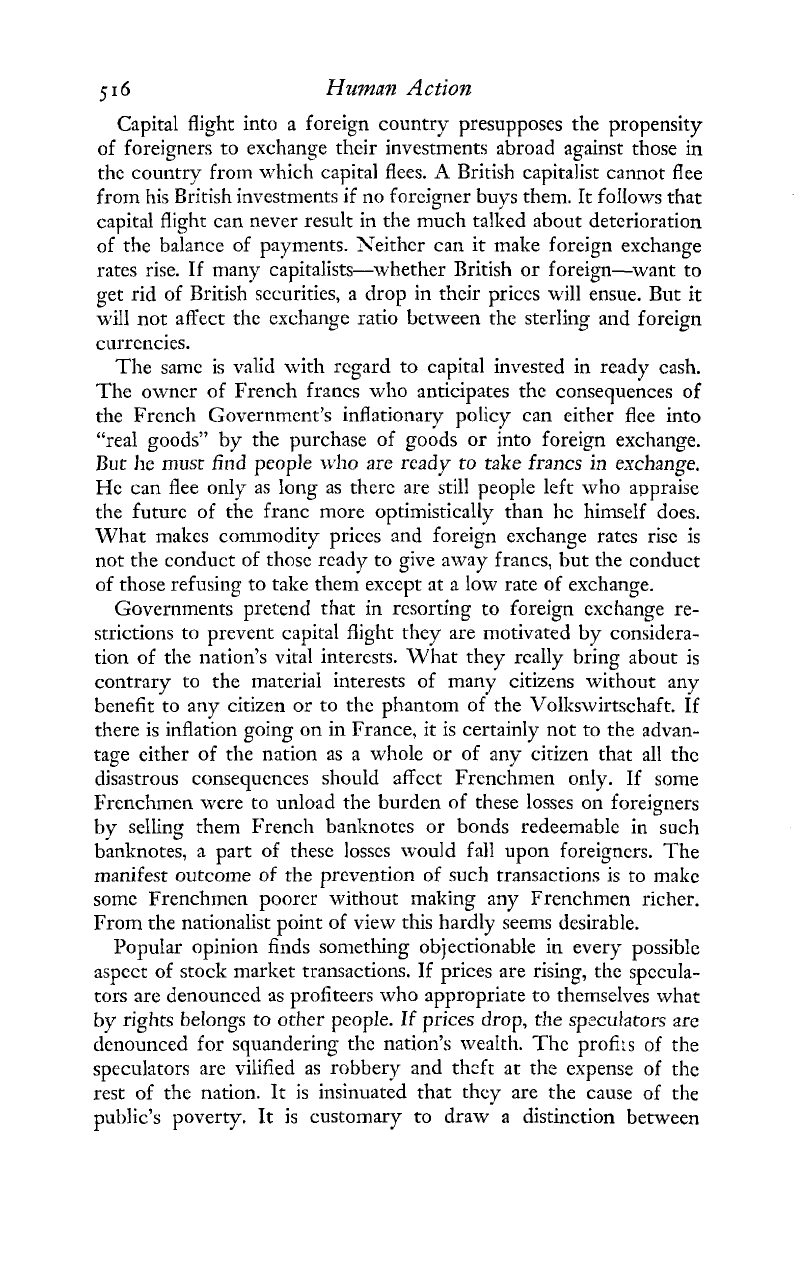
516
Human
Action
Capital flight into a foreign country presupposes the propensity
of foreigners to exchange their investments abroad against those in
the country from which capital flees.
A
British capitalist cannot flee
from his British investments if no foreigner buys them. It foilows that
capital flight can never result in the much talked about deterioration
of the balance of payments. Seither can it tnake foreign exchange
rates rise. If many capitalists-whether British or foreign-want to
get rid of British securities, a drop in their prices will ensue. But it
u41 not affect the exchange ratio between the sterling and foreign
currencies.
The same is valid with regard to capital invested in ready cash.
The owner of French francs who anticipates the consequences of
the French Government's inflationary policy can either flee into
"real goods" by the purchase of goods or into foreign exchange.
But he must find people \vho
are
ready to take francs
in
exchange.
He can flee only as long as there are still people left who appraise
the future of the franc more optimistically than
hc
himself does.
What makes commodity prices and foreign exchange rates rise is
not the conduct of those ready to give away francs, but the conduct
of those refusing to take them except at a low rate of exchange.
Governments pretend that in resorting to foreign exchange re-
strictions to prevent capital flight they are motivated by considera-
tion of the nation's vital interests. What they really bring about is
contrary to the materiai interests of many citizens without any
benefit to any citizen or to the phantom of the Volkswirtschaft. If
there is inflation going on in France, it is certainly not to the advan-
tage either of the nation as a whole or of any citizen that all the
disastrous consequences should affect Frenchmen only. If some
Frenchmen were to unload the burden of these losses on foreigners
hy
selling them French banknotes or bonds redeemable in such
banknotes, a part of these losses would fall upon foreigners. The
manifest outcome of the prevention of such transactions is to make
some Frenchmen poorer without malting any Frenchmen richer.
From the nationalist point of view this hardly seems desirable.
PopuIar opinion finds something objectionable in every possible
aspect of stock market transactions. If prices are rising, the specula-
tors are denounced as profiteers who appropriate to themsclves what
by rights belongs to other people.
If
prices drop, the spxulators are
denounced for squandering the nation's wealth. The profi:s of the
speculators are vilified as robbery and thzft at the expense of the
rest of the nation.
It
is insinuated that they are the cause of the
public's poverty. It is customary to draw
a
distinction between
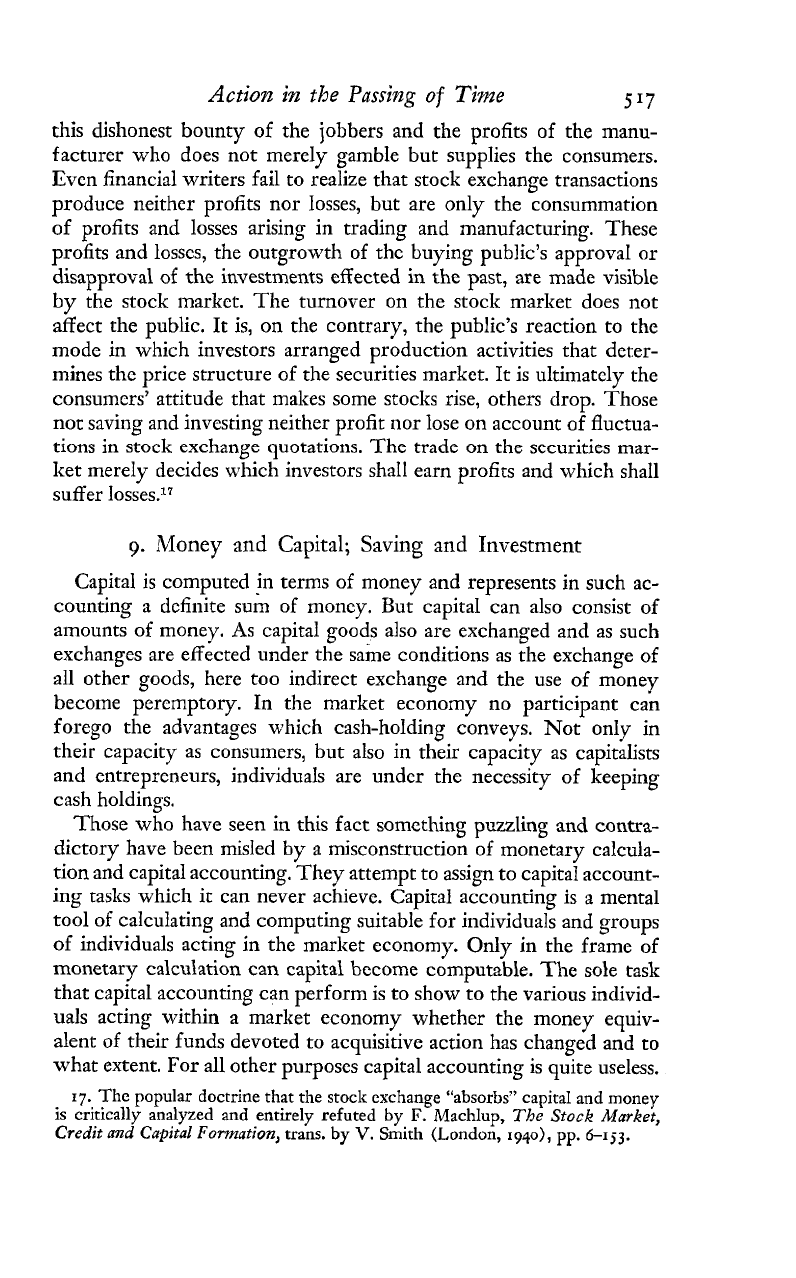
Action in the
Passing
of
Time
this dishonest bounty of the jobbers and the profits of the manu-
facturer who does not merely gamble but supplies the consumers.
Even financial writers fail to realize that stock exchange transactions
produce neither profits nor losses, but are only the consummation
of profits and losses arising in trading and manufacturing. These
profits and losses, the outgrowth of the buying public's approval or
disapproval
of
the investments effected
in
the past, are made visible
by the stock market. The turnover on the stock market does not
affect the public. It is, on the contrary, the public's reaction to the
mode in which investors arranged production activities that det.er-
mines the price structure of the securities market. It is ultimately the
consumers' attitude that makes some stocks rise, others drop. Those
not saving and investing neither profit nor lose on account of fluctua-
tions in stock exchange quotations. The trade on the securities mar-
ket merely decides which investors shaIl earn profits and which shall
suffer losses.1T
9.
Money and Capital; Saving and Investment
Capital is computed in terms of money and represents in such ac-
counting a definite sum of money. But capital can also consist of
amounts of money. As capital goods also are exchanged and as such
exchanges are effected under the same conditions as the exchange of
all other goods, here too indirect exchange and the use of money
become peremptory. In the market economy no participant can
forego the advantages which cash-holding conveys. Not only in
their capacity as consumers, but also in their capacity as capitalists
and entrepreneurs, individuals are under the necessity of keeping
cash holdings.
Those who have seen
in
this fact something puzzling and contra-
dictory have been misled by a misconstruction of monetary calcula-
tion and capital accounting. They attempt to assign to capital account-
ing
tasks which it can never achieve. Capital accounting is a mental
tool of calculating and computing suitable for individuals and groups
of individuals acting in the market economy. Only in the frame of
monetary calculation can capital become computable. The sole task
that capital accounting can perform is to show to the various individ-
uals acting within a market economy whether the money equiv-
alent of their funds devoted to acquisitive action has changed and to
what extent. For all other purposes capital accounting is quite useless.
17.
The popular doctrine that the stock exchange "absorbs" capital
and
money
is critically analyzed and entirely refuted by
F.
Machlup,
The
Stock
Marker,
Credit
and Capital Formation,
trans.
by
V.
Smith
(London,
1940)~
pp.
6-1
jj.
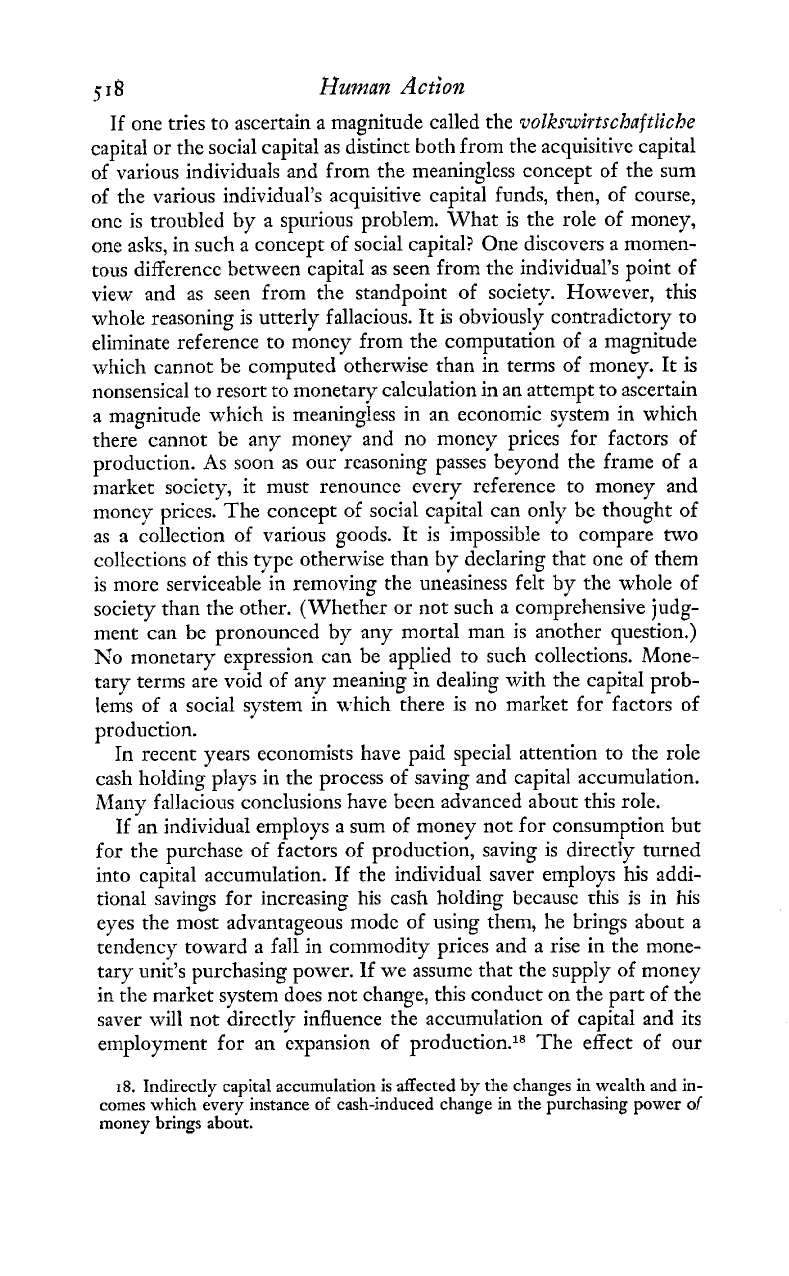
518
Hunzan
Action
If one tries to ascertain a magnitude called the
volks.'~i~tschaftliche
capital or the social capital as distinct both from the
acquisitive
capital
of various individuals and from the meaningless concept of the sum
of the various individual's acquisitive capital funds, then, of course,
one is troubled by a spurious problem. What is the role of money,
one asks, in such a concept of social capital? One discovers a momen-
tous difference between capita1 as seen from the individual's point of
view and as seen from the standpoint of society. However, this
whole reasoning is utterly fallacious. It is obviously contradictory to
eliminate reference to money from the computation of a magnitude
which cannot be computed otherwise than in terms of money. It
is
nonsensical to resort to monetary calculation in an attempt to ascertain
a magnitude which is meaningIess in an economic system in which
there cannot be any money and no money prices for factors of
production. As soon as our reasoning passes beyond the frame of a
market society, it must renounce every reference to money and
money prices. The concept of social capital can only be thought of
as a collection of various goods. It is impossible to compare nvo
colIections of this type otherwise than by declaring that one of them
is more serviceable in removing the uneasiness felt by the whole of
society than the other. (Whether or not such a comprehensive judg-
ment can be pronounced by any mortal man is another question,)
No monetary expression can be applied to such collections. Mone-
tary terms are void of any meaning in dealing with the capital prob-
lems of a social system in which there is no market for factors of
production.
In recent years economists have paid special attention to the role
cash holding plays in the process of saving and capital accumulation.
Many fallacious conclusions have been advanced about this role.
If an individual employs a sum of money not for consumption but
for the purchase of factors of production, saving is directly turned
into capital accumulation. If the individual saver employs his addi-
tionai savings for increasing his cash holding because this is in his
eyes the most advantageous mode of using them, he brings about a
tendency toward a fall in commodity prices and a rise in the mone-
tary unit's purchasing power. If we assume that the supply of money
in the market system does not change, this conduct on the part of the
saver will not directly influence the accumulation of capital and its
employment for an expansion of production.18 The effect of our
18.
Indirectly capital accumulation
is
affected by the changes in wealth and in-
comes which every instance
of
cash-induced change
in
the purchasing power
of
money brings about.
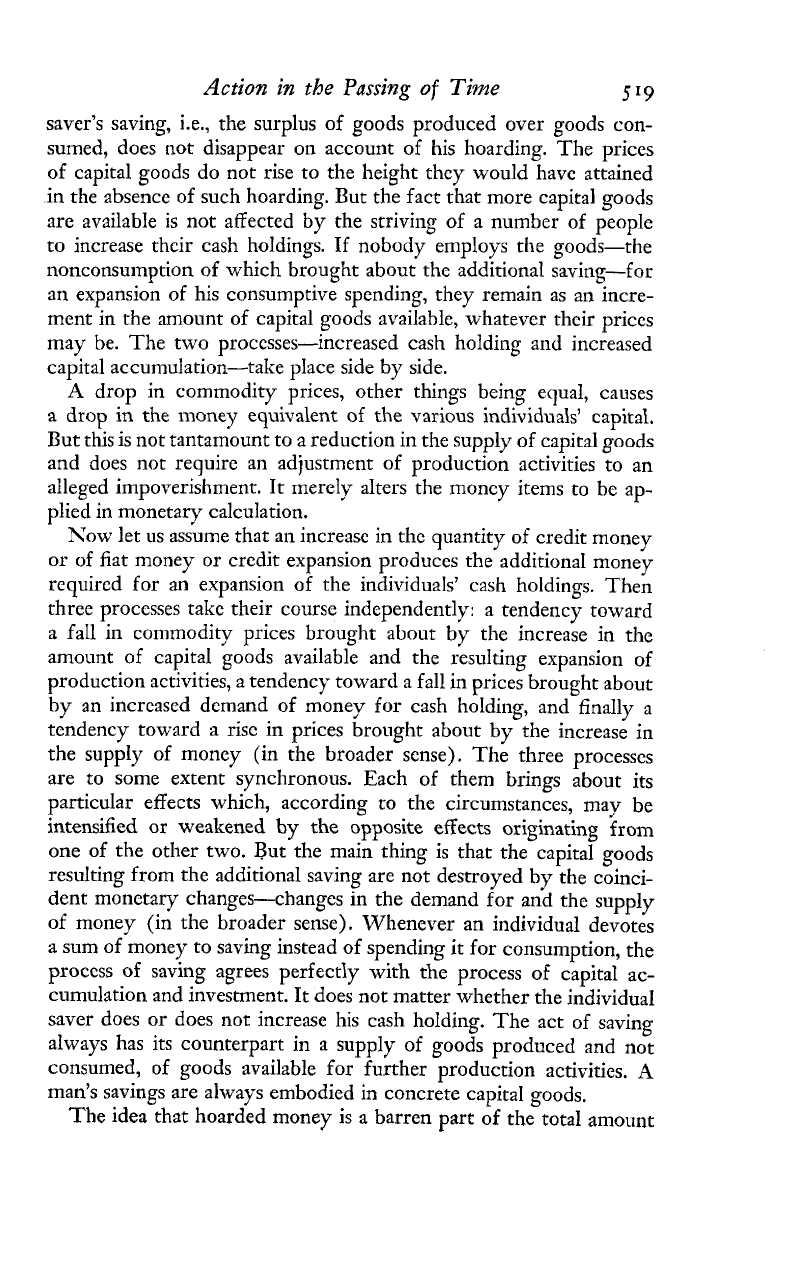
Action in the Passing
of
Time
519
saver's saving, i.e., the surplus of goods produced over goods con-
sumed, does not disappear on account of
his
hoarding. The prices
of capital goods do not rise to the height they would have attained
in the absence of such hoarding. But the fact that more capital goods
are available is not affected by the striving of a number of people
to increase their cash holdings. If nobody employs the goods-the
nonconsumption of which brought about thc additional saving-for
an expansion of his consumptive spending, they remain as an incre-
ment in the amount of capital goods available, whatever their prices
may be. The two processes-increased cash holding and increased
capital accumulation-take place side by side.
A
drop in commodity prices, other things being equal, causes
a
drop
in
the money equivalent of the various individuals' capital.
But this is not tantamount to a reduction
in
the supply of capital goods
and does not require an adjustment of prod~~ction activities to an
alleged impoverishment. It merely alters the moncy items to be ap-
plied in monetary calculation.
Now let us assume that an increase in thc quantity
of
credit money
or of fiat money or credit expansion produces the additional money
required for an expansion of the individuals' cash holdings. Then
three processes takc their course indcpendently: a tendency toward
a
fall in commodity prices brought about by the increase in the
amount of capital goods available and the resulting expansion of
production activities, a tendency toward a fall in prices brought about
by an increased demand of money for cash holding, and finally a
tendency toward a rise in prices brought about by the increase in
the supply of money (in the broader sense). The three processes
are to some extent synchronous. Each of them brings about its
particular effects which, according to the circumstances, may be
intensified or weakened by the opposite effects originating from
one of the other two. But the main thing is that the capital goods
resulting from the additional saving are not destroyed by the coinci-
dent monctary changes-changes in the demand for and the supply
of money (in the broader sense). Whenever an individual devotes
a sum of money to saving instead of spending it for consumption, the
proccss of saving agrees perfectly with the process of capital ac-
cumulation and investment. It does not matter whether the individual
saver does or does not increase his cash hoIding. The act of saving
always has its counterpart in a supply of goods produced and not
consumed, of goods available for further production activities.
A
man's savings are always embodied
in
concrete capital goods.
The idea that hoarded money is a barren part of the total amount
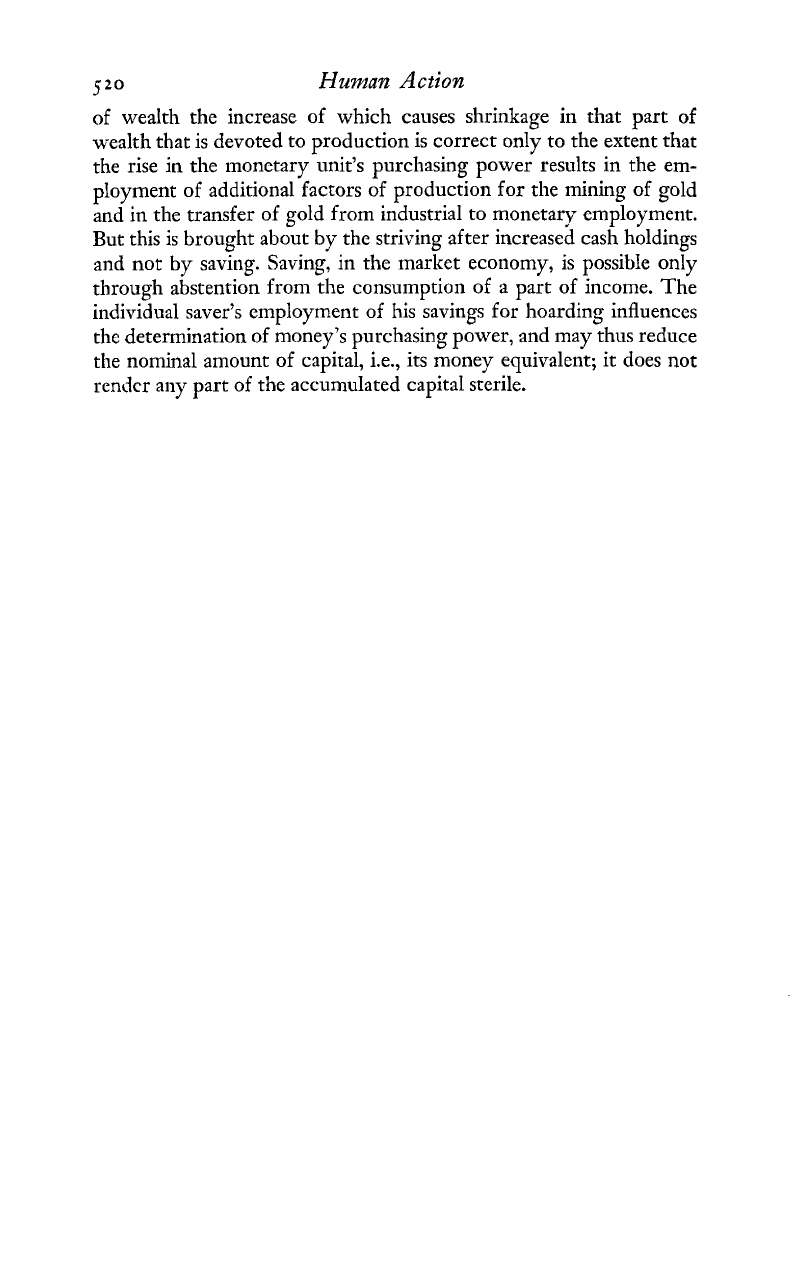
520
Human
Action
of wealth the increase of which causes shrinkage in that part of
wealth that is devoted to production is correct only to the extent that
the rise in the monetary unit's purchasing power results in the em-
ployment of additional factors of production for the mining
of
gold
and
in
the transfer of gold from industrial to monetary employment.
But this is brought about
by
the striving after increased cash holdings
and not by saving. Saving, in the tnarket economy, is possibIe only
through abstention from the consumption of a part of income. The
individual saver's employment of his savings for hoarding influences
the determination of money's purchasing power, and may thus reduce
the nominal amount of capital, i.e., its money equivalent; it does not
rendcr any part of the accumulated capital sterile.
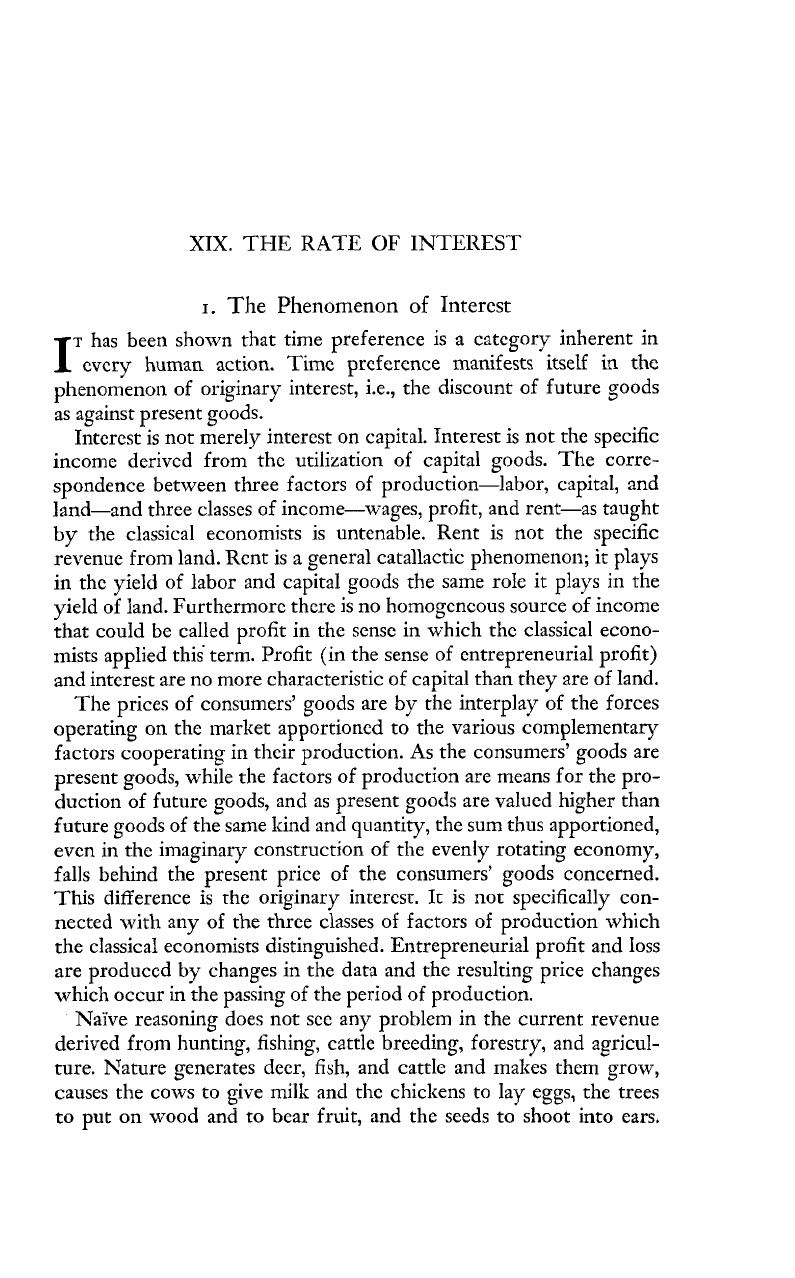
XIX. THE RATE OF INTEREST
I.
The Phenomenon of Interest
T
has been shown that time preference is a category inherent in
I
every human action. Time preference manifests itself
in
the
phenomenon of originary interest, i.e., the discount of future goods
as against present goods.
Interest is not merely interest on capital. Interest is not the specific
income derived from the utilization of capital goods. The corre-
spondence between three factors of production-labor, capital, and
land-and three classes of income-wages, profit, and rent-as taught
by the classical economists is untenable. Rent is not the specific
revenue from land. Rent is a general catallactic phenomenon; it plays
in the yield of labor and capital goods the same role it plays in the
yield of land. Furthermore there is no homogcneous source of income
that could be called profit in the sense in which the classical econo-
mists applied this term. Profit (in the sense of entrepreneurial profit)
and interest are no more characteristic of capital than they are of land.
The prices of consumers' goods are by the interplay of the forces
operating on the market apportioned to the various complementary
factors cooperating in their production. As the consumers' goods are
present goods, while the factors of production are means for the pro-
duction of future goods, and as present goods are valued higher than
future goods of the same kind and quantity, the sum thus apportioned,
even in the imaginary construction of the evenly rotating economy,
falls behind the present price of the consumers' goods concerned.
This difference
is
the originary interest. It is not specifically con-
nected with any of the three classes of factors of production which
the classical economists distinguished. Entrepreneurial profit and loss
are produced
by
changes in the data and the resulting price changes
which occur in the passing of the period of production.
Naive reasoning does not see any problem in the current revenue
derived from hunting, fishing, cattle breeding, forestry, and agricul-
ture. Nature generates deer, fish, and cattle and makes them grow,
causes the cows to give milk and the chickens to lay eggs, the trees
to put on wood and to bear fruit, and the seeds to shoot into ears.
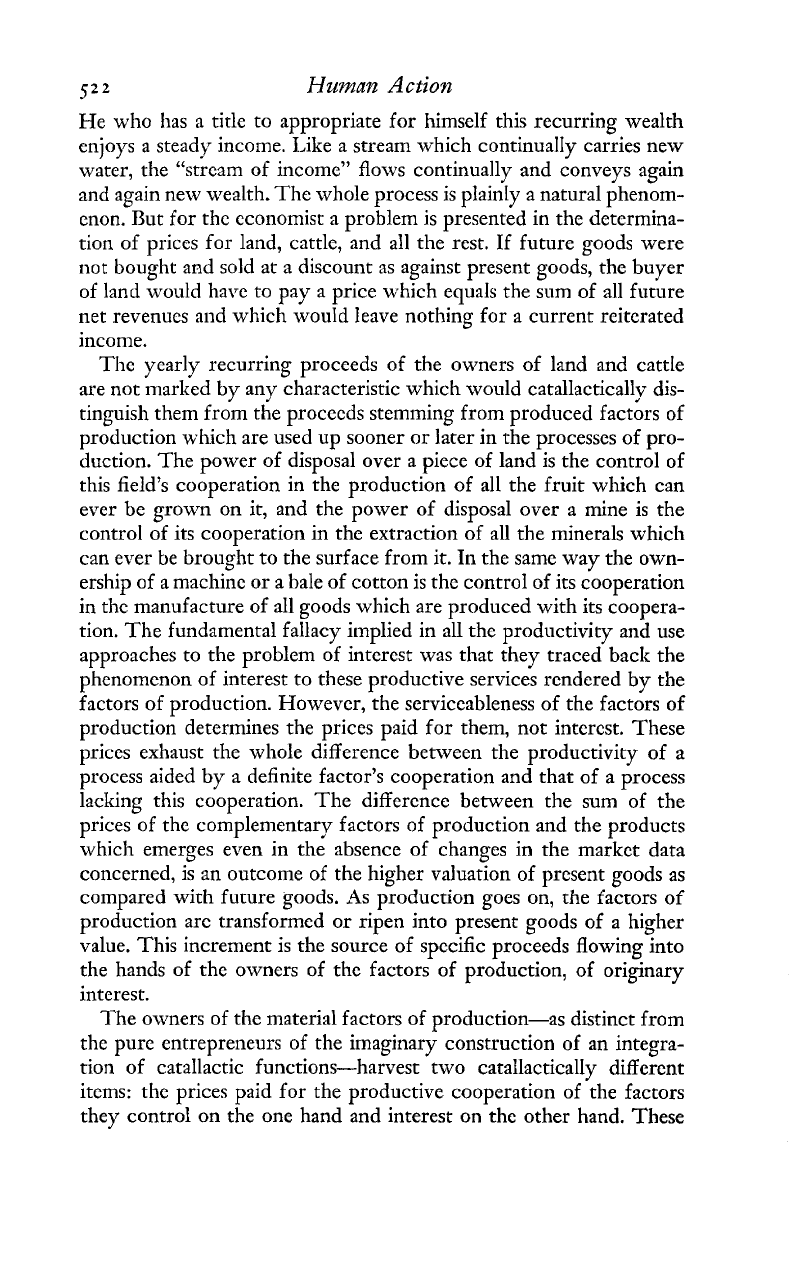
5*2
Human
Action
He who has a title to appropriate for himself this recurring wealth
enjoys a steady income. Like a stream w-hich continualIy carries new
water, the "strcam of income" flows continually and conveys again
and again new wealth. The whole process is plainly
a
natural phenom-
enon. But for thc
economist
a prohlem is presented in the determina-
tion of prices for land, cattle, and all the rest. If future goods were
not
bought and sold at a discount as against present goods, the buyer
of land would ham to pay a price which equals the sum of all future
net revenues and which would leave nothing for a current reiterated
income.
The yearly recurring proceeds of the owners of land and cattle
are not marked by any characteristic which would catallactically dis-
tinguish them from the procecds stemming from produced factors of
production which are used up sooner or later in the processes of pro-
duction. The power of disposal over a piece of land is the control of
this field's cooperation in the production of all the fruit which can
ever be grown on it, and the power of disposal over a mine is the
control of its cooperation in the extraction of all the minerals which
can ever be brought to the surface from it.
In
the same way the own-
ership of a machine or
a
hale of cotton is the control of its cooperation
in thc manufacture of all goods which are produced with its coopera-
tion. The fundamental fallacy implied in all the productivity and use
approaches to the problem of interest was that they traced back the
phcnomcnon of interest to these productive services rendered by the
factors of production. However, the serviceableness of the factors of
production determines the prices paid for them, not interest. These
prices exhaust the whole difference between the productivity of
a
process aided by a definite factor's cooperation and that of a process
lacking this cooperation. The djffercnce between the
sum
of the
prices of the complen~entary factors of production and the products
which emerges even in the absence of changes in the markct data
concerned, is an outcome of the higher valuation of present goods as
compared wih iumre goods. As production goes on, the factors of
production arc transformed or ripen into present goods of
a
higher
value. This increment is the source of specific proceeds flowing into
the hands of the owncrs of thc factors of production, of originary
interest.
The owners of the material factors of production-as distinct from
the pure entrepreneurs of the imaginary construction of an integra-
tion of catallactic functions-harvest two catallactically different
itcms: the prices paid for the productive cooperation of the factors
they control on the one hand and interest on the other hand. These
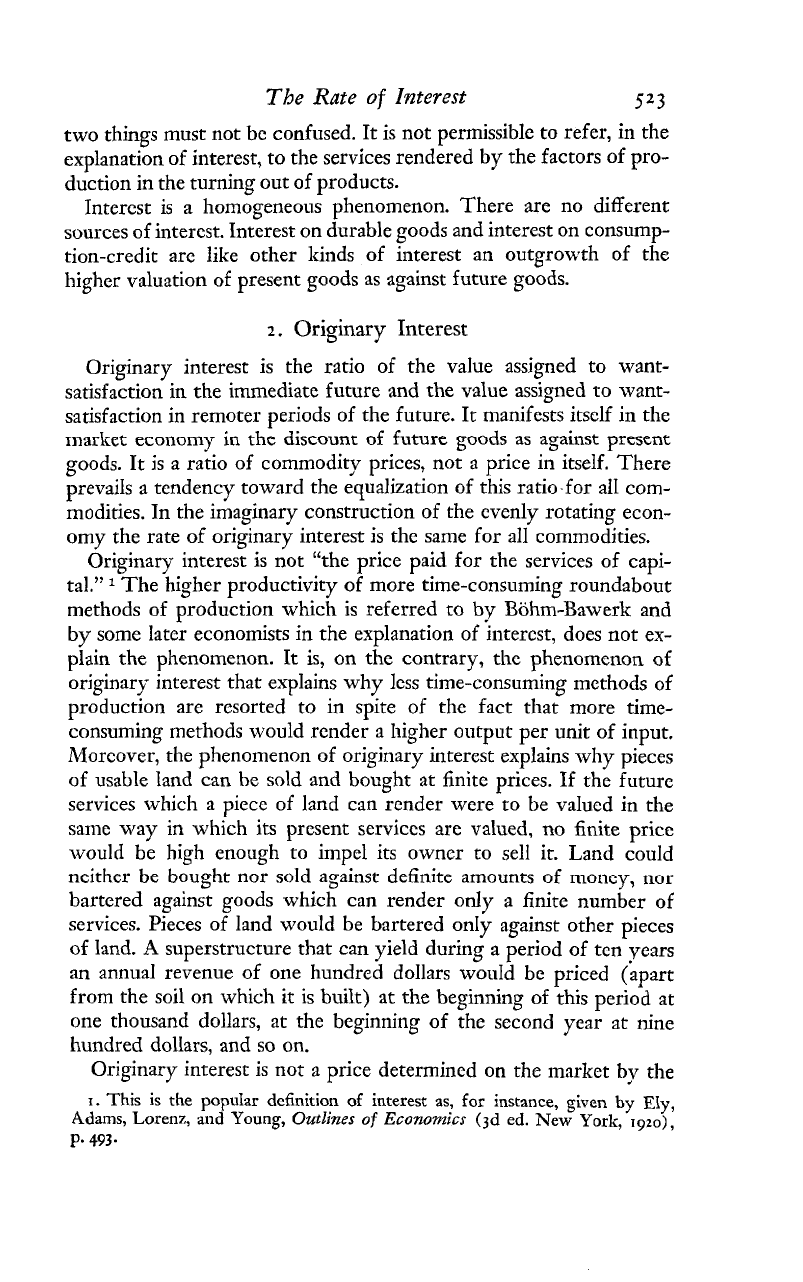
The Rate
of
Interest
523
two things must not be confused. It is not permissible to refer, in the
explanation of interest, to the services rendered by the factors of pro-
duction in the turning out of products.
Intercst is a homogeneous phenomenon. There are no different
sources of interest. Interest on durable goods and interest on consump-
tion-credit are like other kinds of interest an outgrowth of the
higher valuation of present goods as against future goods.
2.
Originary Interest
Originary interest is the ratio of the value assigned to want-
satisfaction in the immediate future and the value assigned to want-
satisfaction in remoter periods of the future. It manifests itself in the
market economy in the discount of future goods as against present
goods. It
is
a ratio of commodity prices, not
a
price in itself. There
prevails a tendency toward the equalization of this ratio for a11 com-
modities. In the imaginary construction of the evenly rotating econ-
omy the rate of originary interest is the same for all commodities.
Originary interest is not "the price paid for the services of capi-
tal." The higher productivity of more time-consuming roundabout
methods of production which is referred to
by
Bohm-Bawerk and
by some later economists in the explanation of interest, does not ex-
plain the phenomenon. It
is,
on the contrary, the
phenomenon
of
originary interest that explains why lcss time-consuming methods of
production are resorted to in spite of the fact that more time-
consuming methods would render a higher output per unit of input.
Moreover, the phenomenon of originary interest explains why pieces
of usable land can be sold and bought at finite prices. If the future
services which a piece of land can render were to be vaIued in the
same way in which its present services are valued, no finite price
would be high enough to impel its owner to sell it. Land could
ncithcr be bought nor sold against definite amounts of rnoncy, nor
bartered against goods which can render only a finite number of
services. Pieces of land would be bartered only against other pieces
of land.
A
superstructure that can yield during a period of tcn years
an annual revenue of one hundred dollars would be priced (gpart
from the soil on which it is built) at the beginning of this period at
one thousand dollars, at the beginning of the second year at nine
hundred dollars, and so on.
Originary interest is not a price determincd on the market by the
I.
This is
the
popular
definition
of
interest as,
for
instance, given
by
EIy,
Adams,
Lorenz,
and
Young,
Outlines of Economics
(jd
ed.
New
York,
rgzo),
p.
493-
